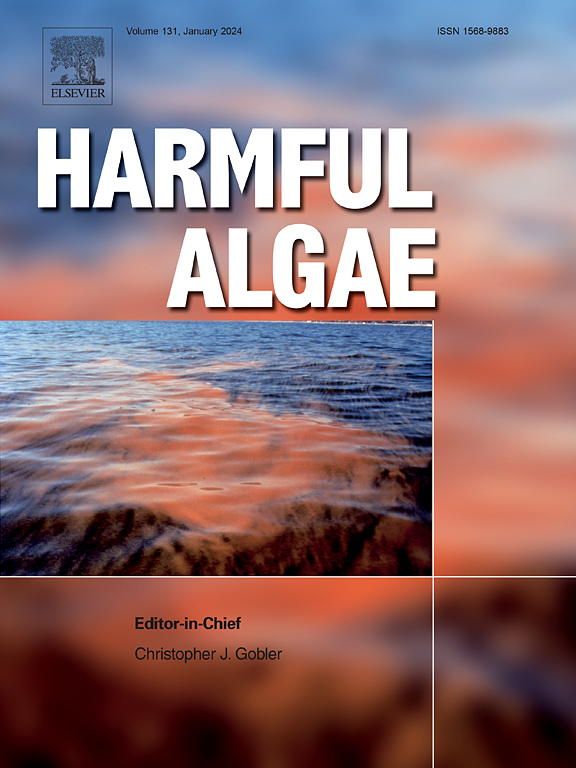Does Microcystis exposure history facilitate adaptation of Diaphanosoma dubium to expanding filamentous cyanobacterium Raphidiopsis raciborskii?
IF 4.5
1区 生物学
Q1 MARINE & FRESHWATER BIOLOGY
引用次数: 0
Abstract
Diaphanosoma, so-called ‘tropical Daphnia’ are widely distributed in warm waterbodies with Microcystis blooms, and are supposed to have high level of tolerance to Microcystis. However, expanding filamentous cyanobacterium, Raphidiopsis raciborskii is increasingly replacing Microcystis, or becoming co-dominant in warm eutrophic waterbodies. Whether previous experience with Microcystis can facilitate adaptation of Diaphanosoma to R. raciborskii or a shift in cyanobacteria assemblage from Microcystis to R. raciborskii will reduce their tolerance to cyanobacteria is debated. We address this question by investigating the performance of fourteen clones from three Diaphanosoma dubium populations differing in cyanobacteria exposure history. They were fed pure diets of cylindrospermopsin-/non-cylindrospermopsin-producing R. raciborskii, microcystin-producing Microcystis aeruginosa and green alga Auxenochlorella pyrenoidosa. The three cyanobacteria all sustained the growth and reproduction of three D. dubium populations, and both somatic and population growth rates increased with dietary PUFA content for each clone, irrespective of manageability and toxicity. Clones with cyanobacteria exposure history have much better performance than those without exposure history on all food types. Moreover, clones with Microcystis exposure history for >40 years, performed better on all food types than clones with R. raciborskii exposure history for <10 years. The results suggest that D. dubium population with much longer bloom exposure history may adapt to being more tolerant of toxic cyanobacteria in the diet. We infer that previous Microcystis exposure experience might facilitate adaptation of D. dubium to R. raciborskii by enhancing their ability to cope with nutritional constraint and toxicity.

微囊藻暴露史是否促进了duaphanosoma对扩大的丝状蓝藻Raphidiopsis raciborskii的适应?
所谓的“热带水蚤”广泛分布在微囊藻繁殖的温暖水体中,对微囊藻有很高的耐受性。然而,扩张的丝状蓝藻Raphidiopsis raciborskii正在逐渐取代微囊藻,或在温暖的富营养化水体中成为共同优势。以前与微囊藻的接触是否能促进透明藻对raciborskii的适应,或者蓝藻组合从微囊藻到raciborskii的转变是否会降低它们对蓝藻的耐耐性,目前还存在争议。我们解决了这个问题,通过调查从三个不同的蓝藻暴露历史的双峰藻种群的14克隆的性能。分别饲喂产柱状精子素/不产柱状精子素的raciborskii、产微囊藻铜绿微囊藻和绿藻pyrenoidorella。3种蓝藻均能维持3个D. duduum种群的生长和繁殖,且无论可管理性和毒性如何,每个克隆的体细胞生长速率和种群生长速率均随饲粮PUFA含量的增加而增加。有蓝藻暴露史的克隆在所有食物类型上的表现都比没有暴露史的克隆好得多。此外,微囊藻暴露史为40年的无性系在所有食物类型上的表现都优于暴露史为10年的无性系。结果表明,具有较长华暴露史的D. dubium种群可能适应对饮食中有毒蓝藻的耐受性更高。我们推测以前的微囊藻暴露经历可能通过增强其应对营养限制和毒性的能力来促进dud对raciborskii的适应。
本文章由计算机程序翻译,如有差异,请以英文原文为准。
求助全文
约1分钟内获得全文
求助全文
来源期刊

Harmful Algae
生物-海洋与淡水生物学
CiteScore
12.50
自引率
15.20%
发文量
122
审稿时长
7.5 months
期刊介绍:
This journal provides a forum to promote knowledge of harmful microalgae and macroalgae, including cyanobacteria, as well as monitoring, management and control of these organisms.
 求助内容:
求助内容: 应助结果提醒方式:
应助结果提醒方式:


